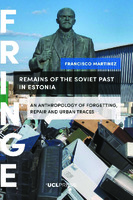Remains of the Soviet Past in Estonia
Abstract
What happens to legacies that do not find any continuation? In Estonia, a new generation that does not remember the socialist era and is open to global influences has grown up. As a result, the impact of the Soviet memory in people’s conventional values is losing its effective power, opening new opportunities for repair and revaluation of the past.
Francisco Martinez brings together a number of sites of interest to explore the vanquishing of the Soviet legacy in Estonia: the railway bazaar in Tallinn where concepts such as ‘market’ and ‘employment’ take on distinctly different meanings from their Western use; Linnahall, a grandiose venue, whose Soviet heritage now poses diffi cult questions of how to present the building’s history; Tallinn’s cityscape, where the social, spatial and temporal co-evolution of the city can be viewed and debated; Narva, a city that marks the border between the Russian Federation, NATO and the European Union, and represents a place of continual negotiation of belonging; and the new Estonian National Museum in Raadi, an area on the outskirts of Tartu, that has been turned into a memory field.
Keywords
Estonia; Communism; Eastern Europe; Soviet; Linnahall; Narva; Russians; TallinnDOI
10.14324/111.9781787353534ISBN
9781787353534OCN
1051775708Publisher
UCL PressPublisher website
https://www.uclpress.co.uk/Publication date and place
2018Series
Fringe,Classification
European history
Sociology and anthropology
Anthropology
Social and cultural anthropology
Far-left political ideologies and movements


 Download
Download